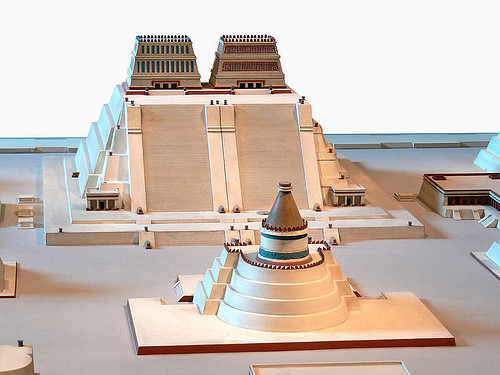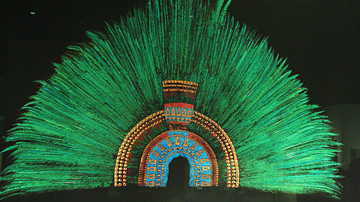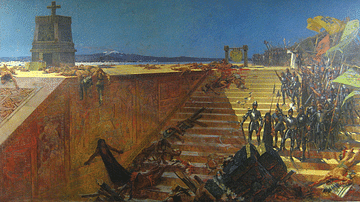
Ahuitzotl (Auitzotl) was an Aztec ruler who reigned between 1486 and 1502 CE. He was one of the greatest generals of the ancient Americas and he left to his nephew, Montezuma, an enlarged and consolidated empire which had been ruthlessly terrorised into submissive acceptance of Aztec rule. With huge building projects and victories celebrated by mass sacrifices of captured enemies to honour the gods, the reign of Ahuitzotl was the Aztec Golden Age.
Accession
Ahuitzotl (pron. A-weet'-zot) was the third son of Aztec king Motecuhzoma I Ilhuicamina (r. 1440-1469 CE). His name, appropriately enough as it would turn out, was associated with a mythical hyper-aggressive otter that lived at the bottom of a lake and ruthlessly preyed on any creature which approached the lake's banks. The creature, often depicted with a human hand at the end of its tail, was used as the name glyph for the king in Aztec commemorative sculpture.
Ahuitzotl took over as the Aztec tlatoani (speaker) or supreme ruler from his half-brother Tizoc (r. 1481-1486 CE) who was poisoned. Tizoc had not been particularly successful in the role after being forced to quash various rebellions and famously losing a battle to the Tarascans. Lord Ahuitzotl was the 8th Aztec ruler and he is described in Aztec texts as youthful, strong, energetic, and audacious. According to the version of his accession recounted by the Spanish chronicler Fray Diego Duran, Ahuitzotl was a mere youth when he took power in 1486 CE and had to be brought from school on the death of Tizoc but he already displayed a great maturity beyond his years. We are also informed that the new tlatoani was helped in his early years by the traditional king's advisor, the Tlacaellel.
The accession of Ahuitzotl is commemorated in a green diorite slab with the year 8 Reed date glyph. On it are both Tizoc and Ahuitzotl while between them is a ball of cactus fibre with cactus needles stuck in it. The two rulers are using needles to let blood from their earlobes in offering to the gods. The blood flows down from the two figures into the gaping jaws of a stylised earth-crocodile creature representing the earth goddess Tlaltecuhtli. The slab now resides in the National Museum of Anthropology in Mexico City.
Expanding the Empire
Ahuitzotl quickly established his reputation as a gifted military leader by winning his first battle in the traditional 'Coronation War' beloved of Aztec rulers. Leading his army in person and fighting alongside his warriors as he would always do, the Toluca Valley rebellions were quashed, booty taken, and sacrificial victims procured. The victory was celebrated with the largest feast and round of gift-giving the Aztec people had ever witnessed.
Ahuitzotl then proceeded to bring the Gulf Coast territories into line after their stubborn refusal to pay tribute. This was another victory, and Ahuitzotl would go on to win many more. Conquering the central valleys of Oaxaca c. 1494 CE the Aztecs moved as far south as the Guatemalan border, or even beyond, in order to encompass lucrative cacao-producing regions. They also campaigned as far west as the Pacific coast, perhaps in a long-term strategy to outflank the Tarascan forts being established by that hostile nation. The result of this expansion was that Ahuitzotl created the largest area yet brought under Aztec control.
Although the Aztec armies concentrated on enemy cities and their empire would only ever be a loose collection of tribute-paying subject states, Ahuitzotl did attempt to establish a more permanent Aztec presence by building Aztec monuments in such conquered cities as Tepoztlan, Malinalco, and Calixtlahuaca. Some local gods were also incorporated into the Aztec pantheon in an effort to further bind the diverse cultures of Mesoamerica. Trade was encouraged in some areas, especially by the pocheca warrior-traders who were given the privileged right to wear jewellery and feathers by Ahuitzotl, such was their importance in his strategy to open up new territories by whatever means suited the situation. At the same time more troublesome peoples (e.g. the Oztoman and Alahuistan) were ruthlessly and systematically wiped out during the reign of Ahuitzotl.
Ahuitzotl also greatly increased the number of human sacrifices carried out in the various Aztec religious ceremonies designed to appease their gods and celebrate military victories. Duran famously recounts how 80,400 war captives were sacrificed over four days atop the Templo Mayor pyramid temple at Tenochtitlan. Most historians discount this number as impossibly high and impractical, settling on a figure nearer 20,000 but still quite enough to fulfil the apocalyptic descriptions by eye-witnesses of temples, plazas, and streets streaming rivers of blood. The scene of this mass sacrifice is depicted in the Codex Telleriano Remensis. Not only did sacrifices help to appease the gods and ensure a continuation of the Aztec world but Ahuitzotl used the spectacle to terrify the visiting rulers of newly conquered territories and ensure their passive compliance to Aztec rule.
Building Projects
Ahuitzotl, besides imperial expansion, also occupied himself with grand building projects in order to beautify the Aztec capital of Tenochtitlan and, in typical Aztec fashion, establish early on that his reign would bring great prosperity to his people. The most significant such project was the expansion of the Templo Mayor. The new temple was completed in 1487 CE, and it was to inaugurate this giant monument to the rain god Tlaloc and war god Huitzilopochtli that the infamous 80,000 plus captives were sacrificed.
Another giant project of Ahuitzotl was the construction of a large canal to bring fresh water from Coyoacan to Tenochtitlan. However, in a version recounted by Duran, the project got off to a bad start when it brought so much water that it flooded the city. The priests blamed the disaster on the fact that Ahuitzotl had rashly killed a ruler of Coyoacan, and so this was revenge from Chalchiuhtlicue, the water goddess.
Death & Successors
Ahuitzotl's reign came to a mysterious end when he contracted a strange and fatal disease, dying in the year 10 Rabbit. In another version of events the king died from a blow to the head while he was trying to escape the flood at Tenochtitlan. Death by a wasting disease suggests that he may well have been poisoned, like his predecessor, such was the competition between members of the ruling family to possess the title which permitted the holder semi-divine status. In a lavish ceremony, Ahuitzotl was cremated on a funeral pyre atop the Templo Mayor and his ashes buried beneath the nearby sacred precinct.
Ahuitzotl would pass on a prosperous empire to the next and tragically last true Aztec ruler, his nephew Motecuhzoma Xocoyotzin (Montezuma) who faced and was murdered by the visitors from the Old World in 1520 CE. During the chaos of the Spanish conquest, Ahuitzotl's son Cuauhtemoc seized power and resisted the invaders until 1525 CE. Even after his death, the legend of Ahuitzotl the great warrior held strong for his son dressed one of his men in the regal clothes of his father, which inspired the Aztec army to a rare, if only temporary, victory during the long siege of Tenochtitlan.










